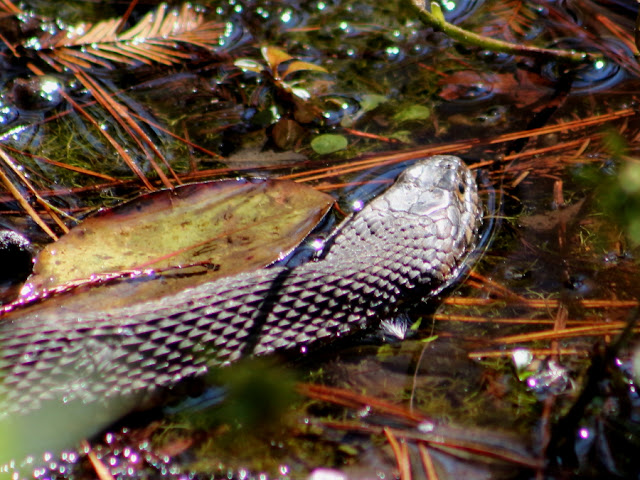We enjoyed a week down in South Carolina to visit family, with the added benefit of missing out on a week of November drab. I knew we were out of our region the very first morning when we were awoken at daybreak by a bird song we don't hear in New Hampshire, a Carolina Wren. On our excursions in the low county, guided by our expert host, we experienced plenty of other southern creatures including this little lizard in a cypress swamp.
 |
| Brown Anole (Anolis sagrei) |
The south has plenty of invasive species of its own, among them is the brown anole, a native of Cuba and the Bahamas which was introduced to America as a pet. Its journey began in Florida and has been making its way northward, expanding its range rapidly by easily out-competing species of native lizards, though it's unlikely to be seen in New Hampshire anytime soon.
And what would a visit to a southern swamp be without a snake?
 |
| Perhaps a Mud Snake. |
I don't know what kind of snake this is, but it may be a Mud Snake based on its coloring and its location at the edge of the swamp, into which it slithered upon our approach.
 |
| You can barely make out the coloring on its underside which makes me think its a mud snake. |
Along the edges of the swamp many southern plants were still in bloom including this hibiscus with a pretty yellow butterfly enjoying its nectar through its long proboscis.
 |
| A Cloudless Sulphur butterfly (Phoebis sennae) on Hibiscus Moscheutos. |
We observed quite a few birds that we do see in the Lakes Region during the summer months including great blue herons and great egrets.
 |
| Great Egret (Ardea alba) on a lagoon. |
 |
| Great blue heron on the far side of the same lagoon. |
The great egret is rare visitor to New Hampshire's lakes, while the great blue heron is abundant here.
The snowy egret looks like a smaller version of the great egret except it has a black beak and those yellow feet:
 |
| Snowy Egret (Egretta thula) on a different lagoon. |
I've never seen a snowy egret in New Hampshire though their range maps show them breeding along the east coast as far north as Casco Bay in Maine.
Other fun birds to watch are the ubiquitous brown pelicans along the ocean shoreline and in the creeks.
 |
| A group of brown pelicans (Pelecanus occidentalis) take a free ride up Shem Creek on the flood tide. |
I also observed multiple flocks of vultures soaring overhead on the warm updrafts.
 |
| Black vultures searching for food on the updrafts. |
It wasn't until I saw a few closer to earth that I realized they are a different species than the turkey vultures we have in New Hampshire.
 |
| Black Vulture (Coragyups atratus) |
These are Black Vultures which don't travel north of Long Island, but according to the Cornell Lab of Ornithology, where they do overlap with turkey vultures they follow the turkey vultures to locate food because unlike turkey vultures, black vultures have a poor sense of smell. The white underside of the wing tips was the most obvious difference, but the black head versus the the red head of the turkey vulture is also distinctive.
Finally, I'll share a couple of southern plants, one small, one giant. First the small:
 |
| Rice growing about four feet high along the Ashley River. |
Rice was once a major cash crop in South Carolina, starting in 1685 when a ship carrying rice from Madagascar was forced into Charleston by a storm. The industry flourished until the end of the Civil War when labor became scarce; rice farming ceased in South Carolina by the early 1900s and is now rarely grown. [REF: Carolina Plantation Rice] This was a demonstration field at the Middleton Plantation.
Now the large plant:
 |
| A Live Oak generously adorned with Spanish Moss. |
Live oaks can grow for centuries, up to 400, maybe even 500 years. This specimen and several others at Middleton Plantation were saved from the lumber axe to provide shade around the plantation's mansion.
As soon as we arrived back in New Hampshire we were greeted to a day of snow squalls, and after being no more than a dozen feet above sea level all week, I needed a blue-sky mountain fix. The Squam Range's Mt. Morgan and Percival filled the need nicely.
 |
| Looking south from Mount Morgan. |
Many thanks again to our gracious host for another great visit to the Low Country! Now I'm ready for snow!
No comments:
Post a Comment